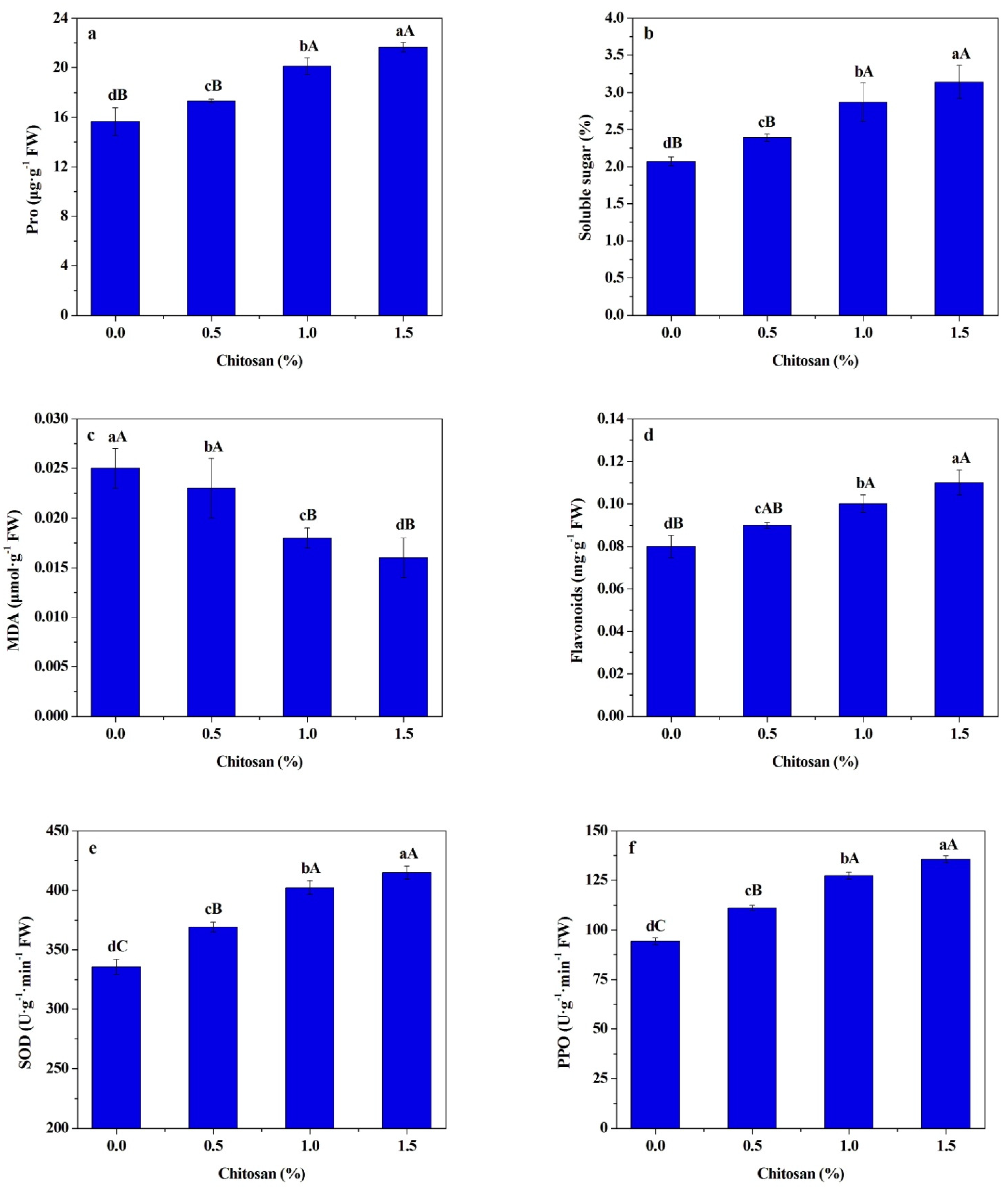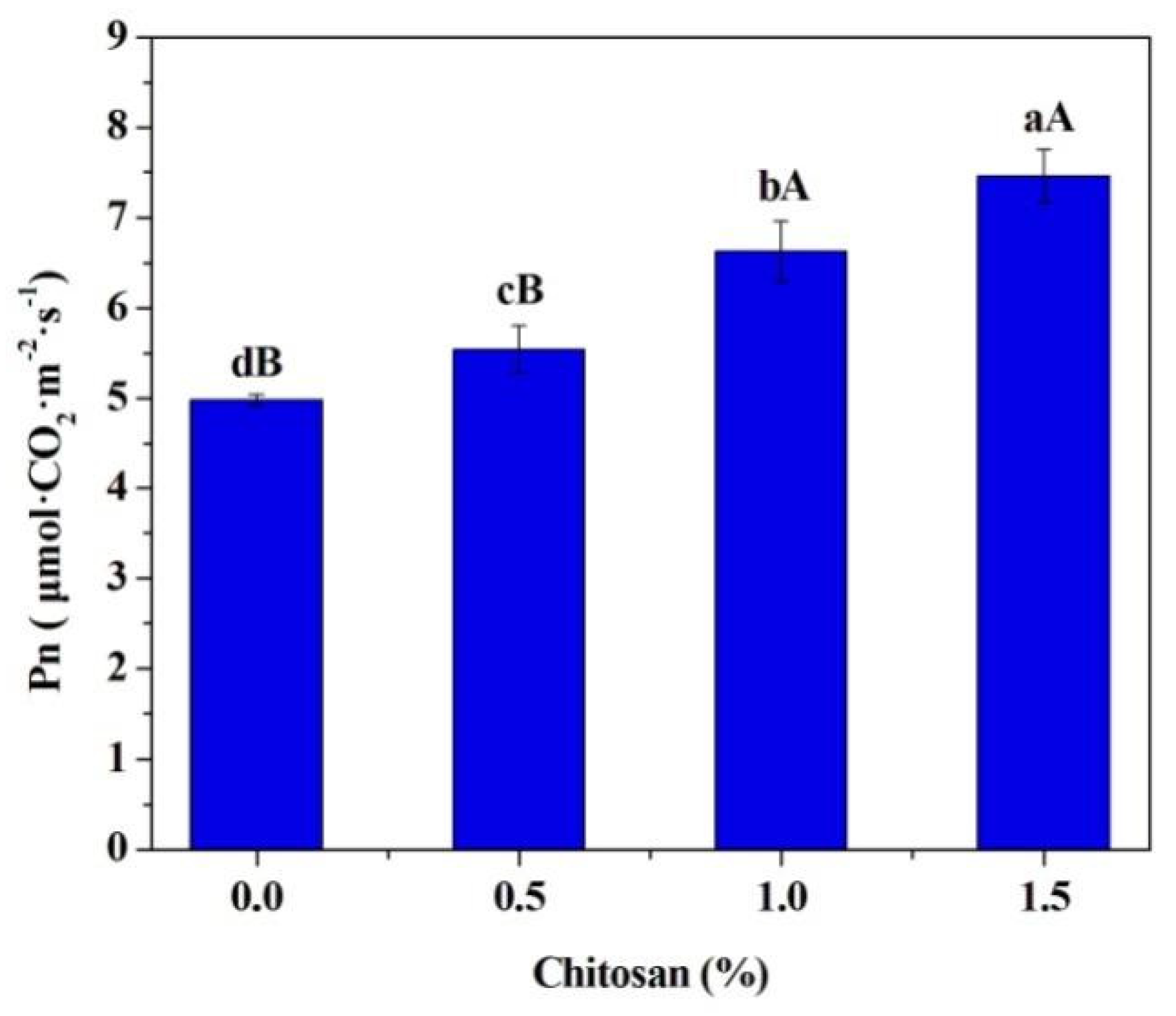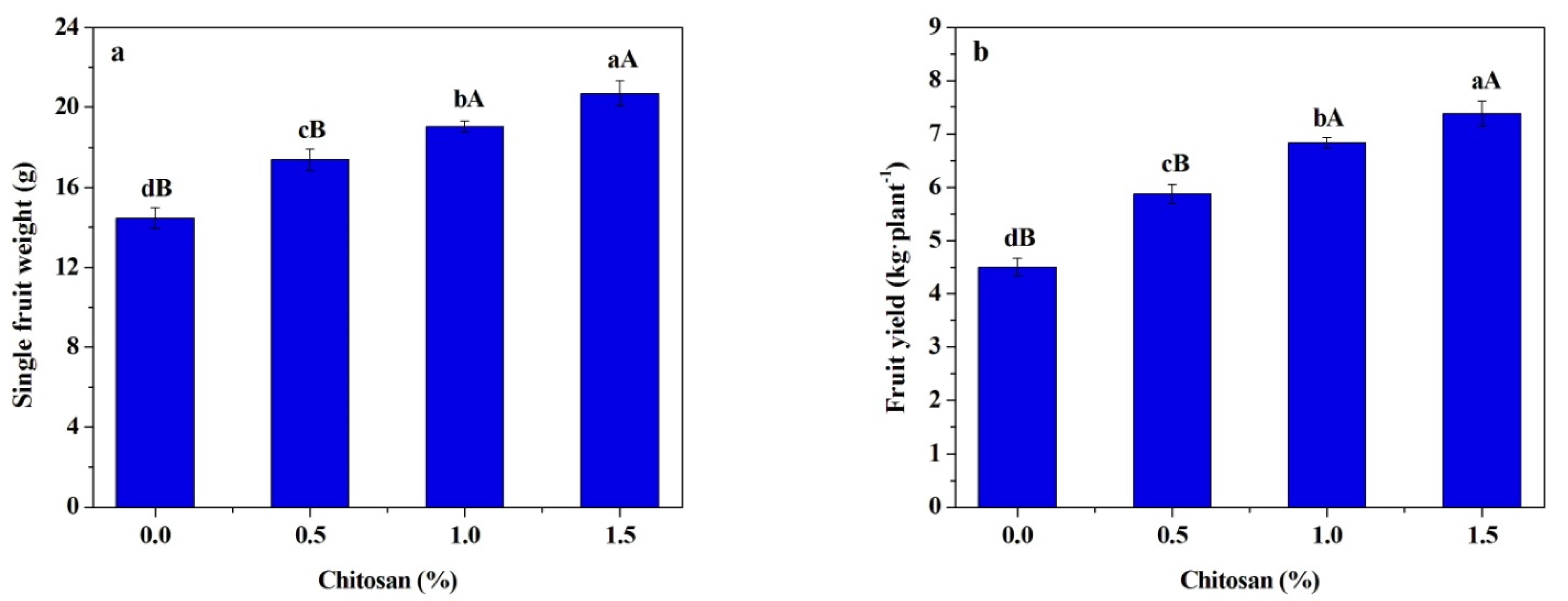Chitosan Can Induce Rosa roxburghii Tratt. against Sphaerotheca sp. and Enhance Its Resistance, Photosynthesis, Yield, and Quality
Abstract
:1. Introduction
2. Materials and Methods
2.1. Materials
2.2. Field Site
2.3. Field-Inducing Control Experiment of Sphaerotheca sp. in R. roxburghii
2.4. Determination of Chitosan Control Effect against Sphaerotheca sp., and Resistance Parameters, Photosynthetic Rate and Chlorophyll of R. roxburghii Leaves
2.5. Determination of Yield and Quality of R. roxburghii
2.6. Statistical Analyses
3. Results
3.1. Field-Inducing Control Effect of Chitosan against Sphaerotheca sp. of R. roxburghii
3.2. Effects of Chitosan on Proline, Soluble Sugar, Malonaldehyde, Flavonoids, SOD, and PPO Activity of R. roxburghii Leaves
3.3. Effects of Chitosan on Photosynthetic Rate and Chlorophyll Content of R. roxburghii Leaves
3.4. Effects of Chitosan on Yield and Quality of R. roxburghii
4. Discussion
5. Conclusions
Author Contributions
Funding
Data Availability Statement
Conflicts of Interest
References
- Wang, L.T.; Lv, M.J.; An, J.Y.; Fan, X.H.; Dong, M.Z.; Zhang, S.D.; Wang, J.D.; Wang, Y.Q.; Cai, Z.H.; Fu, Y.J. Botanical Characteristics, Phytochemistry and Related Biological Activities of Rosa roxburghii Tratt Fruit, and Its Potential Use in Functional Foods: A Review. Food Funct. 2021, 12, 4. [Google Scholar] [CrossRef]
- Qi, L.L.; Zhou, R.L. The Healthcare Function and Development Trend of Toxburgh Rose. Food Res. Dev. 2016, 37, 212–214. [Google Scholar]
- Wang, D.J.; Lu, M.; Ludlow, R.A.; Zeng, J.W.; Ma, W.T.; An, H.M. Comparative Ultrastructure of Trichomes on Various Organs of Rosa roxburghii. Microsc. Res. Tech. 2021, 84, 1–9. [Google Scholar] [CrossRef]
- Liu, X.Z.; Zhao, H.B.; Li, Y.F.; Yu, Z.H.; Liu, X.H.; Huang, M.Z. Identification and Oenological Properties Analysis of a Strain of Hanseniaspora uvarum from Rosa roxburghii. Food Ferment. Ind. 2020, 46, 97–104. [Google Scholar]
- Huang, X.; Yan, H.; Zhai, L.; Yang, Z.; Yi, Y. Characterization of the Rosa roxburghii Tratt Transcriptome and Analysis of MYB Genes. PLoS ONE 2019, 14, e0203014. [Google Scholar] [CrossRef] [Green Version]
- Hao, M.H.; Zhang, F.; Liu, X.X.; Zhang, F.; Wang, L.J.; Xu, S.J.; Zhang, J.H.; Ji, H.L.; Xu, P. Qualitative and Quantitative Analysis of Catechin and Quercetin in Flavonoids Extracted from Rosa roxburghii Tratt. Trop. J. Pharm. Res. 2018, 17, 71–76. [Google Scholar] [CrossRef] [PubMed] [Green Version]
- Xu, P.; Liu, X.; Xiong, X.; Zhang, W.; Cai, X.; Qiu, P.; Hao, M.; Wang, L.; Lu, D.; Zhang, X.; et al. Flavonoids of Rosa roxburghii Tratt Exhibit Anti-Apoptosis Properties by Regulating PARP-1/AIF. J. Cell Biochem. 2017, 118, 3943–3952. [Google Scholar] [CrossRef] [PubMed]
- Chen, Y.; Liu, Z.J.; Liu, J.; Liu, L.K.; Zhang, E.S.; Li, W.L. Inhibition of Metastasis and Invasion of Ovarian Cancer Cells by Crude Polysaccharides from Rosa roxburghii Tratt In Vitro. Asian Pac. J. Cancer Prev. 2014, 15, 10351–10354. [Google Scholar] [CrossRef] [Green Version]
- Fan, W.G.; Pan, X.J.; Chen, H.; Yang, H.R.; Gomg, F.F.; Guan, J.Y.; Wang, M.L.; Mu, R. Effects of Oxalic Acid on the Nutrient of Calcareous Cultivated Soil and Leaf, Fruit Yield and Quality of Rosa roxburghii Tratt. J. Fruit Sci. 2021, 38, 1113–1122. [Google Scholar] [CrossRef]
- Han, L.; Liu, X.D.; Huang, W.Y.; Wu, X.M. Occurrence and Control Technology of Powdery Mildew in Rose roxburgh Tratt. China Fruits 2021, 1, 6–10. [Google Scholar] [CrossRef]
- Yan, K.; Wang, J.L.; Zhou, Y.; Fu, D.P.; Huang, R.M. Efficacy of Five Fungicidesin Rosa roxburghii Tratt against Sphaerotheca Sp. Agrochemicals 2018, 57, 609–610. [Google Scholar]
- Meena, R.S.; Kumar, S.; Datta, R.; Lal, R.; Vijayakumar, V.; Brtnicky, M.; Marfo, T.D. Impact of Agrochemicals on Soil Microbiota and Management: A Review. Land 2020, 9, 34. [Google Scholar] [CrossRef] [Green Version]
- Wang, Q.; Zhang, C.; Long, Y.; Wu, X.; Su, Y.; Lei, Y.; Ai, Q. Bioactivity and Control Efficacy of the Novel Antibiotic Tetramycin Against Various Kiwifruit Diseases. Antibiotics 2021, 10, 289. [Google Scholar] [CrossRef] [PubMed]
- Massi, F.; Torriani, S.; Borghi, L.; Toffolatti, S. Fungicide Resistance Evolution and Detection in Plant Pathogens: Plasmopara viticola as a Case Study. Microorganisms 2021, 9, 119. [Google Scholar] [CrossRef] [PubMed]
- Vlot, A.C.; Sales, J.H.; Lenk, M.; Bauer, K.; Brambilla, A.; Sommer, A.; Nayem, S. Systemic Propagation of Immunity in Plants. New Phytol. 2020, 229, 1234–1250. [Google Scholar] [CrossRef]
- Lopez-Moya, F.; Suarez-Fernandez, M.; Lopez-Llorca, L.V. Molecular Mechanisms of Chitosan Interactions with Fungi and Plants. Int. J. Mol. Sci. 2019, 20, 332. [Google Scholar] [CrossRef] [Green Version]
- Yan, K.; Luo, Z.L.; Hu, F.L.; Wu, T.H.; Tian, H.S.; Huang, R.M.; Yan, J.C. Ascorbic Acid 6% AS Inducing Resistance against Sphaerotheca Sp. in Rosa roxburghii Tratt. Agrochemicals 2017, 56, 528–530. [Google Scholar] [CrossRef]
- Verlee, A.; Mincke, S.; Stevens, C.V. Recent Developments in Antibacterial and Antifungal Chitosan and Its Derivatives. Carbohyd. Polym. 2017, 164, 268–283. [Google Scholar] [CrossRef]
- Chakraborty, M.; Hasanuzzaman, M.; Rahman, M.; Khan, M.; Bhowmik, P.; Mahmud, N.U.; Tanveer, M.; Islam, T. Mechanism of Plant Growth Promotion and Disease Suppression by Chitosan Biopolymer. Agriculture 2020, 10, 624. [Google Scholar] [CrossRef]
- Torres-Rodriguez, J.A.; Reyes-Pérez, J.J.; Castellanos, T.; Angulo, C.; Hernandez-Montiel, L.G. A Biopomyler with Antimicrobial Properties and Plant Resistance Inducer Against Phytopathogens: Chitosan. Not. Sci. Biol. 2021, 49, 1–15. [Google Scholar] [CrossRef]
- Wang, B.; Zhang, S.; Wang, X.; Yang, S.; Jiang, Q.; Xu, Y.; Xia, W. Transcriptome Analysis of the Effects of Chitosan on the Hyperlipidemia and Oxidative Stress in High-Fat Diet Fed Mice. Int. J. Biol. Macromol. 2017, 102, 104–110. [Google Scholar] [CrossRef]
- Xoca-Orozco, L.Á.; Cuellar-Torres, E.A.; Gonz á lez-Morales, S.; Gutiérrez-Martínez, P.; López-Garcí, U.; Herrera-Estrella, L.; Vega-Arreguín, J.; Chacón-López, A. Transcriptomic Analysis of Avocado Hass (Persea americana Mill) In the Interaction System Fruit-Chitosan-Colletotrichum. Front. Plant Sci. 2017, 8, 956. [Google Scholar] [CrossRef] [Green Version]
- Rahman, M.; Mukta, J.A.; Sabir, A.A.; Gupta, D.R.; Mohi-ud-din, M.; Hasanuzzaman, M.; Miah, M.G.; Rahman, M.; Islam, M.T. Chitosan Biopolymer Promotes Yield and Stimulates Accumulation of Antioxidants in Strawberry Fruit. PLoS ONE 2018, 13, e0203769. [Google Scholar] [CrossRef]
- Emami Bistgani, Z.; Siadat, S.A.; Bakhshandeh, A.; Ghasemi Pirbalouti, A.; Hashemi, M. Interactive Effects of Drought Stress and Chitosan Application on Physiological Characteristics and Essential Oil Yieldof Thymus daenensis Celak. Crop J. 2017, 5, 407–415. [Google Scholar] [CrossRef]
- Coutinho, T.C.; Ferreira, M.C.; Rosa, L.H.; de Oliveira, A.M.; de Oliveira Júnior, E.N. Penicillium citrinum and Penicillium mallochii: New Phytopathogens of Orange Fruit and Their Control Using Chitosan. Carbohyd. Polym. 2020, 234, 115918. [Google Scholar] [CrossRef]
- El Amerany, F.; Meddich, A.; Wahbi, S.; Porzel, A.; Taourirte, M.; Rhazi, M.; Hause, B. Foliar Application of Chitosan Increases Tomato Growth and Influences Mycorrhization and Expression of Endo-Chitinase-Encoding Genes. Int. J. Mol. Sci. 2020, 21, 535. [Google Scholar] [CrossRef] [Green Version]
- Berger, L.R.R.; Stamford, N.P.; Willadino, L.G.; Laranjeira, D.; de Lima, M.A.B.; Malheiros, S.M.M.; Stamford, T.C.M. Cowpea Resistance Induced Against Fusarium oxysporum f. Sp. tracheiphilum by Crustaceous Chitosan and by Biomass and Chitosan Obtained from Cunninghamella elegans. Biol. Control 2016, 92, 45–54. [Google Scholar] [CrossRef]
- Obianom, C.; Romanazzi, G.; Sivakumar, D. Effects of Chitosan Treatment on Avocado Postharvest Diseases and Expression of Phenylalanine Ammonia-Lyase, Chitinase and Lipoxygenase Genes. Post. Biology Tech. 2019, 147, 214–221. [Google Scholar] [CrossRef]
- Zhang, C.; Long, Y.H.; Wang, Q.P.; Li, J.H.; An, H.M.; Wu, X.M.; Li, M. The Effect of Preharvest 28.6% Chitosan Composite Film Sprays for Controlling Soft Rot on Kiwifruit and Its Defense Responses. Hortic. Sci. 2019, 46, 180–194. [Google Scholar] [CrossRef] [Green Version]
- Zhang, C.; Long, Y.H.; Li, J.H.; Li, M.; Xing, D.K.; An, H.M.; Wu, X.M.; Wu, Y.Y. A Chitosan Composite Film Sprayed before Pathogen Infection Effectively Controls Postharvest Soft Rot in Kiwifruit. Agronomy 2020, 10, 265. [Google Scholar] [CrossRef] [Green Version]
- El-Mohamedya, R.S.R.; Abd El-Aziz, M.E.; Kamel, S. Antifungal Activity of Chitosan Nanoparticles against Some Plant Pathogenic Fungi In Vitro. Agric. Eng. Int. CIGR J. 2019, 21, 201–209. [Google Scholar]
- Farag, S.M.A.; Elhalag, K.M.A.; Mohamed, H.; Hagag, M.H.; Khairy, A.S.M.; Ibrahim, H.M.; Saker, M.T.; Messiha, N.A.S. Potato Bacterial Wilt Suppression and Plant Health Improvement after Application of Different Antioxidants. J. Phytopathol. 2017, 65, 522–537. [Google Scholar] [CrossRef]
- Fan, Z.; Qin, Y.; Liu, S.; Xing, R.; Yu, H.; Li, P. Chitosan Oligosaccharide Fluorinated Derivative Control Root-Knot Nematode (Meloidogyne incognita) Disease Based on the Multi-Efficacy Strategy. Mar. Drugs. 2020, 18, 273. [Google Scholar] [CrossRef]
- Liang, W.L.; Yu, A.X.; Wang, G.D.; Zheng, F.; Hu, P.T.; Jia, J.L.; Xu, H.H. A Novel Water-Based Chitosan-La Pesticide Nanocarrier Enhancing Defense Responses in Rice (Oryza sativa L.) Growth. Carbohyd Polym. 2018, 199, 437–444. [Google Scholar] [CrossRef]
- Xing, K.; Zhu, X.; Peng, X.; Qin, S. Chitosan Antimicrobial and Eliciting Properties for Pest Control in Agriculture: A Review. Agron. Sustain. Dev. 2015, 35, 569–588. [Google Scholar] [CrossRef] [Green Version]
- Li, P.; Cao, Z.; Wu, Z.; Wang, X.; Li, X. The Effect and Action Mechanisms of Oligochitosan on Control of Stem Dry Rot of Zanthoxylum bungeanum. Int. J. Mol. Sci. 2016, 17, 1044. [Google Scholar] [CrossRef] [PubMed]
- Shi, Z.J.; Wang, F.; Lu, Y.Y.; Deng, J. Combination of Chitosan and Salicylic Acid to Control Postharvest Green Mold Caused by Penicillium digitatum in Grapefruit Fruit. Sci. Hortic. 2018, 223, 54–60. [Google Scholar] [CrossRef]
- Dzung, N.A.; Khanh, V.T.P.; Dzung, T.T. Research on Impact of Chitosan Oligomers on Biophysical Characteristics, Growth, Development and Drought Resistance of Coffee. Carbohydr. Polym. 2011, 84, 751–755. [Google Scholar] [CrossRef]
- Wang, Q.; Zhang, C.; Wu, X.; Long, Y.; Su, Y. Chitosan Augments Tetramycin Against Soft Rot in Kiwifruit and Enhances Its Improvement for Kiwifruit Growth, Quality and Aroma. Biomolecules 2021, 11, 1257. [Google Scholar] [CrossRef]
- Mondal, M.; Puteh, A.B.; Dafader, N.C.; Rafii, M.Y.; Malek, M.A. Foliar Application of Chitosan Improves Growth and Yield in Maize. J. Food Agric. Environ. 2013, 11, 520–523. [Google Scholar]
- Lei, C.; Ma, D.; Pu, G.; Qiu, X.; Du, Z.; Hong, W.; Li, G.; Ye, H.; Liu, B. Foliar Application of Chitosan Activates Artemisinin Biosynthesis in Artemisia annua L. Ind. Crop. Prod. 2011, 33, 176–182. [Google Scholar] [CrossRef]



| Chitosan (%) | Incidence Rate (%) | Disease Index | Control Effect (%) |
|---|---|---|---|
| 0 | 48.15 ± 6.42 aA | 13.39 ± 1.00 aA | |
| 0.5 | 29.63 ± 6.41 bB | 6.88 ± 0.36 bB | 48.12 ± 5.75 cB |
| 1.0 | 18.52 ± 6.41 cC | 4.08 ± 0.09 cC | 69.30 ± 1.49 bA |
| 1.5 | 14.81 ± 6.41 dC | 3.60 ± 0.14 cC | 72.87 ± 2.88 aA |
| Chitosan (%) | Chlorophyll a | Chlorophyll b | Chlorophyll a + b | Chlorophyll a/b |
|---|---|---|---|---|
| 0 | 2.87 ± 0.29 bB | 2.07 ± 0.06 bA | 1.38 ± 0.10 bA | 4.94 ± 0.35 bcA |
| 0.5 | 3.03 ± 0.10 bB | 2.15 ± 0.05 bA | 1.41 ± 0.08 abA | 5.18 ± 0.06 bA |
| 1.0 | 3.35 ± 0.20 aA | 2.32 ± 0.03 aA | 1.45 ± 0.08 aA | 5.66 ± 0.21 aA |
| 1.5 | 3.49 ± 0.18 aA | 2.38 ± 0.05 aA | 1.46 ± 0.10 aA | 5.87 ± 0.16 aA |
| Chitosan (%) | Vitamin C (mg·g−1) | Soluble Solid (%) | Soluble Sugar (%) | Total Acidity (%) | Soluble Protein (%) | Flavonoids (mg·g−1) | SOD Activity (U·g−1 FW) |
|---|---|---|---|---|---|---|---|
| 0 | 17.83 ± 1.12 d | 10.24 ± 0.11 d | 3.03 ± 0.12 d | 2.46 ± 0.11 d | 12.82 ± 0.66 d | 0.095 ± 0.005 c | 373.61 ± 6.91 d |
| 0.5 | 19.59 ± 1.09 c | 11.26 ± 0.25 c | 3.38 ± 0.08 c | 2.88 ± 0.10 c | 13.63 ± 0.55 c | 0.106 ± 0.005 cb | 410.95 ± 4.42 c |
| 1.0 | 22.31 ± 0.52 b | 12.08 ± 0.24 a | 3.84 ± 0.12 b | 3.43 ± 0.13 ab | 14.75 ± 0.62 b | 0.115 ± 0.005 b | 437.78 ± 6.25 b |
| 1.5 | 24.07 ± 1.33 a | 12.45 ± 0.33 a | 4.17 ± 0.13 a | 3.75 ± 0.11 a | 15.46 ± 0.39 a | 0.125 ± 0.013 a | 451.55 ± 6.11 a |
Publisher’s Note: MDPI stays neutral with regard to jurisdictional claims in published maps and institutional affiliations. |
© 2021 by the authors. Licensee MDPI, Basel, Switzerland. This article is an open access article distributed under the terms and conditions of the Creative Commons Attribution (CC BY) license (https://creativecommons.org/licenses/by/4.0/).
Share and Cite
Li, J.; Guo, Z.; Luo, Y.; Wu, X.; An, H. Chitosan Can Induce Rosa roxburghii Tratt. against Sphaerotheca sp. and Enhance Its Resistance, Photosynthesis, Yield, and Quality. Horticulturae 2021, 7, 289. https://doi.org/10.3390/horticulturae7090289
Li J, Guo Z, Luo Y, Wu X, An H. Chitosan Can Induce Rosa roxburghii Tratt. against Sphaerotheca sp. and Enhance Its Resistance, Photosynthesis, Yield, and Quality. Horticulturae. 2021; 7(9):289. https://doi.org/10.3390/horticulturae7090289
Chicago/Turabian StyleLi, Jiaohong, Zhenxiang Guo, Yue Luo, Xiaomao Wu, and Huaming An. 2021. "Chitosan Can Induce Rosa roxburghii Tratt. against Sphaerotheca sp. and Enhance Its Resistance, Photosynthesis, Yield, and Quality" Horticulturae 7, no. 9: 289. https://doi.org/10.3390/horticulturae7090289
APA StyleLi, J., Guo, Z., Luo, Y., Wu, X., & An, H. (2021). Chitosan Can Induce Rosa roxburghii Tratt. against Sphaerotheca sp. and Enhance Its Resistance, Photosynthesis, Yield, and Quality. Horticulturae, 7(9), 289. https://doi.org/10.3390/horticulturae7090289





